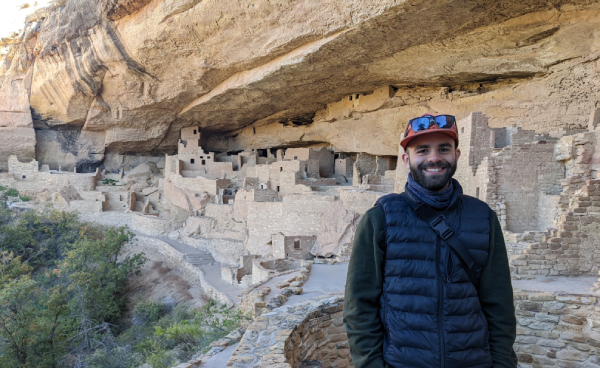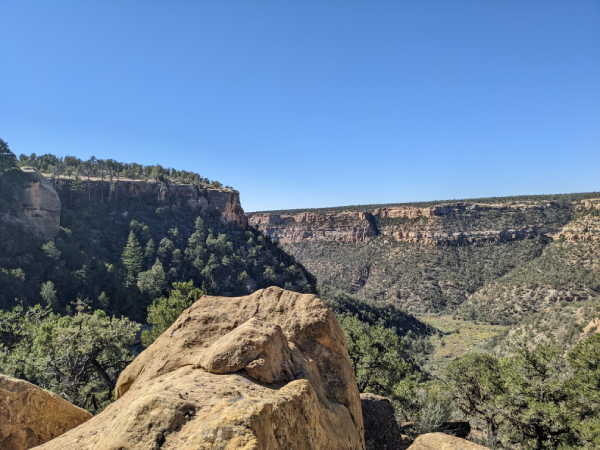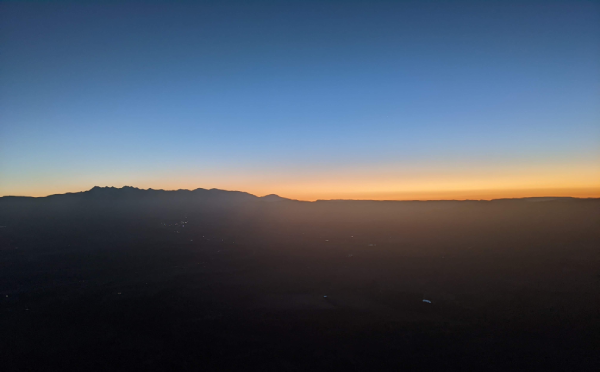I found a small BLM campground just outside the park which made getting into Mesa Verde quite easy in the morning. I had a tour of the Cliff Palace scheduled for 9 AM and it took about 45 minutes or so to get into that area of the park.
There are 5 archeological sites within the park that are only accessible via a ranger-led tour. The three most popular are Cliff Palace, Long House, and Balcony House. I couldn’t get a reservation for the latter two but I was still pleased. Cliff Palace is the largest and the most famous of the three.
The group was roughly forty or fifty people large and we all went down the staircase carved into the side of the cliff together. We waited just outside the site while the previous group finished up. One of the rangers gave us a brief history of Cliff Palace and the Puebloan people. It was basically a review of what I had learned at the museum the day before.

The site was “rediscovered” by the Wetherill brothers in 1888, though the site was well known by the Native population in the area. The brothers were ranchers nearby. Legend has it that they saw the cliff dwelling while grazing their cattle on the plateau. Through a snowstorm in the middle of winter. It’s more likely that they heard about it from the Natives in the area and let others know about it once they located it.
After the discovery, the brothers became amateur archeologists and started studying the site. Other archeologists frequented the area and more and more of these cliff dwellings were found. Over six hundred known dwellings are located here. The area was made into a national park in 1906 in order to protect these sites from theft and vandalism.
The site itself was incredibly impressive. Some restoration has been done over the years but for the most part, the site is made up of the original building materials. About the size of a small city block, approximately 100 people lived at the site at its height.
Originally the Puebloan people lived on top of the mesa in pit houses but over time moved into these cliff dwellings. They were better protected from the elements on the cliffside. And the water supply in these areas was consistent.
The sandstone is porous and when it rains (or when the snow on the mesa top melts) the water trickles down through the sandstone until it gets to a layer that it can no longer pass through. The water pours slowly out of the cliff wall and the Puebloan people used this water. In this way, a water well was practically built into the dwelling.
The people ended up leaving this area and moving south around 1200 AD. Researchers are still unsure why they left but drought and poor farming conditions are probably the best bet. These people traded with other groups throughout the southwest and they probably heard of better living conditions elsewhere from them.
We were able to spend about half an hour at the site and the ranger gave us insight into what some of the different areas of the dwelling were used for. The kiva was the most important room in the dwelling. It was similar to the pithouses that these people used to live in. You could only enter from the roof via a ladder.
The kiva was a community gathering place. At the change of the seasons, men would gather here and perform religious ceremonies and prepare the community. It was a holy place.
Once I finished up at the Cliff Palace I took a drive to a few other lookouts but the cliff dwellings weren’t so easy to see. I finished up the day with the Petroglyph Trail. After a two-and-a-half-mile hike, the payoff point is one of the few petroglyph panels that you can find in the park.

Mesa Verde is not the most beautiful park that I have visited. The main draw is the archeological sites. But the hike was still awesome and I really enjoyed it. Mesa Verde, which means “green table” in Spanish is definitely an appropriate name for the park.
I camped at the BLM campsite that night and made the decision to wake up early and enter the park before sunrise. I got to the top of the Point Lookout Trail thirty minutes before sunrise and sat there and enjoyed the view.

The sun rose over the San Juan mountains and I sat there and just reflected on my trip. From this point on it was back to Denver via Durango and Pagosa Springs.